|
WELCOME
TO THE REALM OF THE PHILOSOPHER'S BEAD STONE
In all candor, Ancientbead.com does not purport to be a
bastion of academic rigor. I am neither a bead scientist
nor an expert in this field, but rather, I am an
explorer, captivated by the unique lens that a simple
hole in a piece of stone provides to view our world.
What can be observed through the hole of the bead
This platform serves as a vessel for the stream of
consciousness that flows through that minuscule
aperture, a journey that spans across time and culture.
Freed from the constraints of traditional academia, I've
found myself with the liberty to venture into new
territories of thought, stringing together known facts
in innovative patterns much like the beads themselves.
On this journey I have already made a lot of mistakes,
but I love to seek truth on the path of error,
forgetfulness and foolishness.
The insights presented here are not mere conjectures or
hypotheses. They are extrapolations, drawn from a rich
tapestry of evidence that extends beyond the realm of
books. My assertions are rooted in tangible experiences
and years of immersion in the very cultures these beads
originated from.
The realm of the written word can only take one so far.
To truly understand, one must venture beyond the
confines of libraries and lecture halls, stepping into
the realities where these artifacts were born. Here at
Philosopher's Bead Stone, we delve deep into these
realities, grounding our explorations in the tangible
and experiential, offering you a unique perspective on
the world through the eye of an ancient bead.
The depth of knowledge is
directly proportional to the extent of experiential
understanding. Without first-hand, visceral experiences,
our understanding of the world remains somewhat abstract
and potentially disconnected from reality. It is
essential, for example, to journey on a third-class bus
in a developing country to truly comprehend the nuances
of life there. |
Counterfeit
Beads
The Power
Of DZI
Beads and
Baudrillard
Age
definition
of Beads
Ancient Beads and Greek Individuality |
|
Half-baked loaves of bread
I have a fondness for storing ideas that are yet to
fully mature. Like half-baked loaves of bread, they can
be warmed up, revisited, and served afresh when the time
is ripe. I freely admit that not all the theories and
reflections I put forth here are fully substantiated by
empirical evidence. However, I trust that they possess
an intuitive resonance that points us in meaningful
directions, ripe for further exploration and validation
over time.
And if they fail to stand the test of time and scrutiny,
I am more than willing to dismantle them, for the
pursuit of knowledge is an ever-evolving process. Truth
is the daughter of time.
With this, I warmly invite you to engage with my musings
and share your thoughts. Your perspectives serve as
invaluable contributions to this site and our collective
exploration of the fascinating world of ancient beads
|
|
|

|
Are you touched by the REAL?
Are you moved by the genuine, the
authentic, the REAL? If so, I invite you to explore the
Early Indus Valley Beads
section. There, I delve into the
sparse population of our planet in those ancient times compared to
the teeming billions today. But let's consider this: what proportion of
people living today have the opportunity to interact with something
truly authentic? By authentic, I refer to an artifact,
ancient and crafted by human
hands – be it a bead, a pot, it doesn't matter.
In our contemporary world, we are often surrounded by artificiality –
the "plastic fantastic," the digital illusions that pervade our daily
lives. Many are content with this reality, but I posit that an awakening
is on the horizon. A growing number of people are beginning to rouse
from their digital stupor, yearning for something genuine, not merely a
simulation.
Encountering an Indus bead offers a chance, however fleeting, to step
outside the frenzied tempo of modern materialism. To hold a relic of
five thousand years of silent history in your hands is to touch
authenticity. It's a reminder of how the noise of our modern world often
resembles the sterile perfection of a CD. Now contrast that with the
warm, organic resonance of an old LP. It's in that distinction that you
find the allure of the truly real.
Real is rare
In
Thailand, the quest for authenticity is already in full swing! The Thai
people, with their passion for antiquity, have exhibited an incredible
fervor for collecting ancient artifacts. During a recent visit to this
enchanting country, renowned for its vibrant culture and warm-hearted
people, I was pleasantly surprised to discover an extensive community of
ancient bead enthusiasts. This diverse group spans all ages and
backgrounds, united by their shared love for these historical treasures.
In fact, I was extended an invitation to join an exclusive Facebook
group dedicated to Thai bead aficionados. Would you believe the
membership of this group? An astounding 8,000 strong!
Beads as Mirrors to
Meta-Consciousness
Peter Francis Jr. once
said, "The study of ancient beads is really the study of ancient
people."
However, I propose a more introspective approach: "The study of
ancient beads is really the study of the people who study them,"
which naturally includes self-study.
Our perceptions and interpretations of these beads are largely
projections of our modern mindset and perspectives. Even experts often
know far less about ancient beads and the people who once wore them than
they readily admit. My diverse academic and professional background has
exposed me to various fields of study, and the world of beads is no
exception.
What I find surprising is the unwavering certainty with which some bead
experts assert their private theories as absolute truth. The sin of
pride is universal, but it's particularly jarring when it appears in
academic circles. Perhaps it's the stark contrast between intellectual
acumen and a lack of self-awareness that makes it so conspicuous.
I'm sure many of you reading this have encountered such personalities.
While it might not be a popular assertion, I must admit that the world
of bead studies seems to rank rather high in terms of academic pride.
It's a reminder of how much our own perceptions can shape the way we
view not just the beads, but ourselves and the world around us.
Ancient beads are enshrouded in
mystery. Their small size enables them to traverse thousands of
kilometers, often far from their place of origin, thereby losing their
original context. As a result, ancient beads rarely carry as much
scientifically verifiable information as other artistic artifacts, such
as sculptures. They communicate their stories more subtly than most
other art objects.
When perusing scientific bead literature with its chronologies, it
becomes evident that much of the age determination is based on educated
guesswork. This approach isn't dissimilar from mine, with the notable
distinction being that I am openly acknowledging this fact.
Peter Francis's observation holds true, but due to the inherent
difficulties in determining the exact age and origin of ancient beads,
these artifacts can easily become screens upon which we project our own
selves and, in less fortunate instances, our vanity. These silent
messengers from the past, in their unknowability, have the uncanny
ability to reveal more about us, the observers, than we might initially
expect.
Our own unexamined observer casts its
shadow into the enigmatic hollows of the beads, and an attitude claiming
to know all, rather than unveiling the secrets of the beads, often
paints a portrait of the superficial ego of the observer himself.
No scientist can entirely bypass their own subjective biases during
scientific studies. If they lack a meta-awareness of this fact, then the
study of beads becomes a mirror reflecting more of the observer's
undiscovered ego than the bead itself.
Thus, the study of ancient beads is truly a trans-historic, reciprocal
examination of human nature. It is a process that illuminates not just
the ancient craft and the civilizations that birthed it, but also the
modern mind that seeks to decipher its mysteries.
|

|
BEAD MEDITATION
Guidelines for a Meditative Engagement with Ancient Beads
I'm not here to prescribe how you should interact with your ancient
beads. That remains entirely your choice. However, I'm offering a few
perspectives on the relationship between beads and their bearers within
a meditative context. I hope these might inspire you in cultivating your
personal relationship with your ancient beads.
Introverted meditative bead engagement
Dogs and humans have been inseparable companions for over 10,000 years,
even sharing some genes. A similar kinship can be drawn between
humans and their oldest artistic creations - beads. Over time, beads
have become 'humanized' due to the gradual polishing and chemical
reactions between the bead's surface and
generations of human skin and sweat. Simultaneously, our identities
have been shaped by the narrative power of stones - not just any
ordinary stones, but those sculpted under the lens of our consciousness.
Thus, beads are not only signifiers but also cultivators of pure
consciousness.
This ancient symbiotic relationship emerged from the close, intimate
contact between humans and beads. The introverted bead wearer doesn't
flaunt their beads in public. Instead, they carry them discreetly,
nestled against their skin beneath their clothing.
Engaging with Ancient Beads: A
Constant Practice of Self-Remembrance
In this context, meditation can be seen as a form of
symbol-communication anchored in the sense of touch. The continuous
contact between skin and beads, worn discreetly beneath your clothes,
can serve as a potent reminder to sustain an inward flow of attention.
This can foster a gentle, yet sustained state of meditation that
permeates all aspects of daily life - whether you're eating, walking, or
talking. Each time you feel your personally chosen ancient beads against
your skin, you're prompted to remember your task: to direct your stream
of consciousness inward, rather than outward.
A similar meditative practice was termed "constant self-remembrance" by
the spiritual teacher Gurdjieff. He urged the spiritual seeker to
remember the feeling of 'I' as much as possible. The act of wearing your
personalized ancient beads in constant remembrance can be a powerful
tool in this lifelong exploration and cultivation of inner realities.
Embracing Active Bead-Gazing
Meditation
Ancient beads can serve as invaluable aids in a more focused form of
meditation. In this approach, you hold a bead of your choosing in your
hand while gazing intently at it. This practice engages both your sense
of touch and sight, providing a dual sensory experience. In this
meditative state, I recommend maintaining a focused yet relaxed gaze on
the bead. This may require a little practice, as the essence of
meditation is to strive for effortless effort. If your practice begins
to feel strained, I suggest adopting a soft, defocused gaze. Allow
yourself to 'see without seeing', gently relaxing your visual focus
while maintaining an acute awareness of the sensation of the bead in
your hand as an abstract energy phenomenon. Through this practice,
you'll be cultivating a state of constant bead-remembrance.
Delving Deeper into Bead Meditation
As you settle into your meditative practice, take note of your position.
Symmetry is crucial. Our brain's coherence is closely tied to
symmetrical body positions, thus for optimum energy flow between the
brain and body, maintain a straight alignment of your spine and head.
Exploring Bead-Hand-Meditation
Our brains dedicate significant conscious processing power to our hands,
making them an ideal focus for bead meditation, particularly for
beginners. Holding your bead(s) in your hands engages this potent
connection, enhancing your meditative exploration.
Grasping the Concept of 'Energy'
As you hold your bead(s), you might notice sensations such as tingling,
heat, or a sense of heaviness in your hands. Our conscious awareness
often struggles to recognize experiences for which we lack language. A
simple strategy can help circumvent this limitation. By assigning an
abstract label to these sensations, we can suddenly perceive and feel
inner body experiences that previously evaded our awareness.
The term we'll use is 'energy'.
From this point forward, label any sensation experienced in your
conscious awareness as 'energy'. Avoid attempting to analyze or
categorize these sensations beyond this abstract label. Simply 'know'
them as energy in a straightforward, non-intellectual manner, much like
a child's uncomplicated 'aha' moment of understanding.
The energy phenomenon you're likely to encounter in this context arises
from a feedback loop of sense-amplification in awareness, fostered by
meditation. As you feel the energy in your hands holding the bead(s),
your awareness heightens, leading to a greater sense of this energy, and
so forth.
While it is entirely possible to practice this meditation without beads,
involving an ancient bead activates our symbol-processing faculties,
integrating them into the harmonious symphony of synchronicity in
consciousness. It is also easier to sense the energies in your hands
when holding something perceived as valuable and significant. After all,
our hands were designed for just that purpose.
Embracing Energy as 'One'
As you progress in this meditative loop, a stage will arrive where the
boundary between the inner sensation of your hands and the bead(s)
starts to blur. They merge into a singular entity - the bead-hands. This
sense of energy as 'one' correlates directly with the quality and
intensity of your awareness and consciousness. With time, you may allow
this feeling of energy to permeate the rest of your body. It may flow
into your body, or it may not. Remain present with whatever happens,
minimizing interference through intention. Allow this energy phenomenon
to unfold naturally, with ease and relaxation!
After a few sessions of hand-focused meditation, you might also want to
try lying down and placing the bead(s) on different areas of your body
that you wish to explore.
Feelings as Energy
Those who dare to consciously peek into the laboratory of their own body
will find it brimming with diverse sensations. Typically, we label these
feeling sensations as love, anger, joy, hate, worry, and so forth. On
this level, emotions like love, hate, compassion, or anxiety are merely
chemical weather reports from our inner geographical landscapes. We
often refer to butterflies in the stomach or gut feelings, which brings
us close to the next level of observation. Here, we discover that all
these feelings can be perceived at a more abstract level as "energies".
Fear, when observed with clear awareness, can be perceived or felt as a
chemical energy storm centered somewhere between the throat and the
navel. This energy, in whatever form it manifests, is the very fuel that
propels us on the path of life. To access this secret world, you must
journey into the inner realm of energies and sensations within the
cellular landscapes of your body.
You might wonder about the practical benefits of becoming familiar with
the inner body. As mentioned before, all body energies, regardless of
their form, serve as fuel to keep our body-engine running. We cannot
afford to dismiss any of these energy forms, as they represent valuable
sources of fuel.
Refining Raw Energies
Imagine an oil refinery. Raw oil is pumped from the ground, but no car
engine can run on this unrefined form. The raw oil needs to be refined
into petrol or gas. Similarly, our inner energies - raw and unfiltered -
need to be refined. Feelings that are often considered lower or impure
should not be suppressed; instead, they should be refined so that they
can fuel our human machinery. Feelings of anger or primitive desire,
like all basic instinctive feelings, contain a tremendous amount of
energy. So, how do we refine and transform these raw energies?
The best refinery is pure, intimate, and innocent awareness. Mere
intellectual understanding won't suffice. The best vehicle for this
journey is an awareness that simply observes, a pure witness. It watches
the "gut-storms" of the abdominal life. Yet, it is also an innocent,
intimate, and compassionate observer. This simple, childlike, and
meditative attitude embraces everything in full and loving awareness.
The process of refining these energies can be greatly enhanced by
Bead-Meditation.
The Power of Touch
Among all the five senses, the sense of touch or feeling is the most
fundamental in the process of meditation (based on my personal
experience).
Healing through Feeling
Famous psychologist C. G. Jung wrote, "The foundation of all mental
illness is the avoidance of legitimate suffering." It's often impossible
to regain a genuine feeling of Inner Calm, Contentment, and Well-being
without some therapeutic and cathartic work.
During a Bead-Meditation session, you might experience various strange
sensations within your body. Some might even be painful. But don't
worry! This is one of the best things that can happen. The secret lies
in the fact that the body heals itself through these energies -
especially the uncomfortable feelings! Don't analyze what's happening -
don't label it anything beyond the abstract and almost meaning-empty
word 'energy'.
Embrace Your Feelings: The Path
to Healing
Adopt a neutral state of mind and experience these various energies
without judgement or labeling. Allow your awareness to rest in the
innocent sensation of these feelings. Remember the mantra: Feel to
heal... Here we can repurpose the phrase often used by bodybuilders -
"No pain, no gain". This holds true for the innate healing processes of
the body as well.
In our modern life, we've become so accustomed to avoiding pain that it
has evolved into a powerful, intimidating force that chases us, growing
exponentially with each escape route we create through overstimulation
like smoking, overeating, constant smartphone use, excessive partying,
drinking, and so on.
Consider this:
If you can face it, 'God' can fix it.
If you can feel it, God can heal it.
Enhancing Sensations Through Awareness
Right now, take a moment to feel the myriad of sensations from your
skin: your toes, feet, legs, hands... also notice how your clothes make
contact with your skin. Perhaps you can even feel the sensation of your
hair on your head and the feeling of your face in contact with the air
around you. As you direct your innocent awareness towards these simple
sensory experiences, you'll notice an immediate amplification of these
sensations. This spontaneous amplification is incredibly important.
Defining Awareness and Consciousness
Meanwhile, observe that you can direct your awareness to different
locations - contrary to what we'll define as 'consciousness' here. In
this context, we define consciousness as inherently abstract and
non-localizable in time and space. Consciousness does not depend upon
sensations. On the other hand, awareness is fundamentally rooted in
feeling sensations and is directable.
Let the bead tell your unknown stories
Let me inspire your bead meditation with a few words now:
Your ancient bead and you have become one. You have become ancient and
the story of the bead and your story have become one.
Now feel - I am deliberately avoiding the word "look" - deeper
into this phenomenon - right at this moment it is taking place in your
hands. You will now be able to 'innerstand' several small things so
close to you that your eyes have not been able to see them.
Nevertheless, these insignificant things have been with you your whole life! And behind the curtain
of the obvious, you have been their servant!
THE 'EXTROVERSION' OF BEADS
It is only natural that we also like to show our beads in public now
and then. No harm in that.
However,
in the 'extrovertation' of beads they might loose their power as
enhancers of inner life, while at the same time they gain importance as
signifiers of social status. In this process, they tend to transform from talismen to jewelry.
The Magnificent Royal Insignia:
A King Bead
This exceptional King Bead, most likely crafted as a royal insignia,
signifies the display of social power:

Extroverted Beads as Social Narrators
By wearing your ancient beads in public, outside your clothing, you
offer a glimpse into your story to everyone around you. Consider my
friend
Arthur from Hong Kong, who finds the display of ubiquitous Rolex
watches quite mundane since they're now commonplace. To truly stand out,
you need something unique, perhaps even something you've designed or
created yourself.
By developing your identity, not through luxury brands or personalized
mobile ring tones, but with something that's impossible for others to
replicate, you establish a unique narrative. An ancient bead is full of
distinctive scars; no other bead bears quite the same marks.
Consequently, these scars become your personalized signature, signifying
that your identity isn't owned by any brand.
You've become the author of your own story. You've achieved the freedom
to enter and exit the matrix as you please.
The Duality of Meditation and Malas
Group meditations are a paradox, both a blessing and a challenge.
While they often yield stronger meditative experiences than solitary
practices, they risk suppressing your spiritual individuality in favor
of the group's collective rhythm, consciously or unconsciously. This
social imitation can turn you into a follower rather than a leader.
Still, for certain stages in life, group meditation can prove
beneficial.
In these contexts,
malas,
or prayer beads, often serve as symbols of social cohesion. Wearing a
specific mala signifies your alignment with a particular group,
resonating at a shared frequency. The mala symbolizes a string of beads,
just as you've become an individual strung together with others. You're
empowered as a 'we,' but can no longer tread the solitary path of a
lion.
The Brotherhood of Consciousness and Malas
Conversely, a mala worn privately, hidden beneath clothing, can act
as a potent reminder—a tool for self-remembrance—that a secret
brotherhood and sisterhood of consciousness cultivators always exists.
When you sit alone, you're not truly alone. You're all-one.
Primarily, this all-oneness connects you with other beings who nurture
the Promethean fire of Consciousness. In this string of 108, we are
beads of consciousness bound together by the mathematical mystique of
the Fibonacci sequence.
In its progression, this sequence encompasses all living beings. Let it
serve as a reminder that, while we are unique, we are not exclusively
so.
The Interplay of Extroverted and Introverted Beads and Size
A small bead can harbor a secret known only to you. This secret might be
an incredibly alluring and intricate pattern. Even if you wear such a
bead in public, its beauty may go unnoticed.
Larger beads can also contain minute patterns. However, they tend to
display more noticeable design narratives. There's no need to judge one
as better than the other. The goal here is understanding. The more
perspectives you have—on beads and life—the more freely you can navigate
your existence.
|
|
|
|
|
|

18 * 8 mm
This bead is very attractive in the sense that it is has an
etched eye in the
already naturally occurring eye. The bead hole is made with the
´new´ drilling technique,
so it is not an Indus bead. My guess is that it was made around
700 B.C.
Scan 1
Scan 2
Scan-hole A
Scan-hole B
|
The
Beauty of Imperfection in Beads
My preference leans towards beads with signs of wear and
tear, beads marked with the scars of time. These beads,
much like the wrinkles on an elderly person's face, bear
the signature of lives lived, tiny chronicles of passing
time. A bead marked by the passage of time often carries
a history spanning over a thousand years. It has been in
close proximity to the skin of countless human
generations, each one a bead in the rosary of existence.
A flawless bead, in this sense, isn't truly natural, as
it fails to reflect the imperfections imprinted by
earth,
wind,
fire, and the ceaseless
sweat of human generations. A bead without scars has
no story to recount.
Certainly, a bead that appears perfect can be beautiful.
But a scarred bead can possess a sublime quality. In
Japan, this might be referred to as a
wabi-sabi bead. Sublime beauty is never encapsulated
in perfection. Perfection represents stagnation,
lifelessness. Life, in contrast, is a beautifully
imperfect mathematical anomaly.
As humans, we often attempt to escape pain and death,
idolizing youth and the illusion of perfection in our
fear-driven flight. Personally, I choose the profound
meditation that immerses me into the depth of my own
subconscious darkness, a journey marked by the imperfect
and often merciless beauty of lived experience:
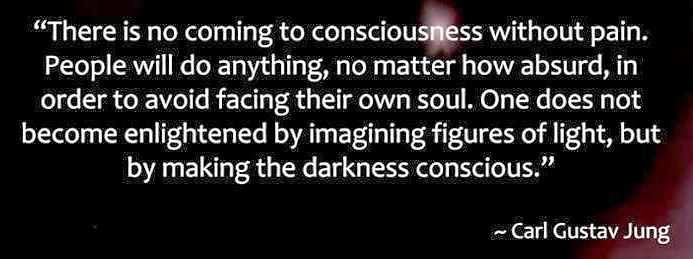 |
Imperfections
as a Pathway to Meditation
Reaching a state of deep meditation with a perfect bead
as the object of focus may seem challenging. After all,
we as humans are inherently imperfect. Thus, we often
require meditation objects or amulets that reflect this
perfect imperfection.
Embracing the Sacred Scar
Indeed, the beauty or sublimity of scarred beads is
not universal, but highly subjective. As humans, we
carry both collective and individual scars, each bearing
its own unique fascination. These scars are
simultaneously sacred and deeply personal. If a scarred
bead resonates with your personal wounds, it could serve
as a potent tool to reveal your inner shadows, bringing
them forth into the light of consciousness. Through this
process, your heart bestows upon an object of its choice
the gift of sublimity.
By acknowledging and accepting our flaws and
imperfections, we can discover profound connections and
significance in our meditation practice. These scarred
beads can act as valuable touchstones that guide us
towards deeper self-understanding and healing.
In the Western world today, the perfect bead is not
necessarily the optimal reflective surface. Rather, an
ancient, scarred bead is more likely to resonate with
us, echoing our own flaws, our broken beauty. This
mirrors our human journey, a path often marked by
challenges and imperfections, yet rich with the
potential for growth, transformation, and sublime
beauty. Are you a
broken beauty?
|

|
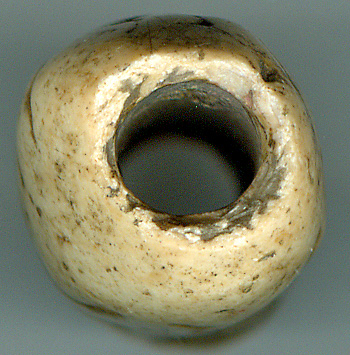
In all chaos there is a cosmos,
in all disorder a secret
order.
C.G.Jung
The Cure for Pain is
Pain - Rumi
Finally, we are ready to thread the bead. Given that our
focus is on beads, it seems fitting to once again adopt
the perspective of the bead hole. In the pursuit of
utilizing pain as a curative for itself, setting aside
time for ritual engagement can be helpful. In these
moments, a scarred bead can serve as the ideal mirror
for introspection, or simply as a tactile focal point
for your hands.
Just like you, the scarred bead is a broken beauty. How
can something flawless reflect your sacred scars? What
must remain intact, however, is the mirror in which you
identify your Self. This mirror is your consciousness,
your self-awareness, and the vehicle for your
meta-cognition. It's the mirror that reflects your
mirror. It constitutes the navigational system from
which you can observe and direct your bodily experience
from a higher vantage point.
Embracing Quasimodo and the Sublime
In the acceptance, even the appreciation, of the
eternal, near-mathematical emergence of
Quasimodo—an archetypal consequence of living—we
find the chance to see ourselves as sublime. Esmeralda
may be beautiful, but Quasimodo embodies the sublime.
Without Quasimodo, life would lose a measure of its
dynamism and surprise, and the existential opportunity
for true
amor
fati (love of one's fate) would diminish.
In this light, embracing our inner Quasimodo becomes not
only a path to self-acceptance but also a means to touch
the sublime in our own being. It's through recognizing
and honoring our 'scars'—our imperfections—that we find
profound depth and meaning in our human journey.
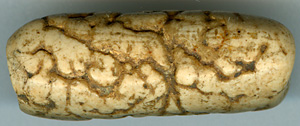
A sublime hunchback bead
Post-modern placebo
However, our scars don't
inherently possess sacredness—it's our perspective that
bestows such sanctity upon them. To sanctify your scars,
to let your own essence shine through their fissures,
you must consciously choose your own placebo in a
post-modern context.
It Takes One to Know One
As an exercise, you could browse through all the scarred
beads displayed on Ancientbead.com and find the one that
mirrors your own personal scars. Perhaps you already
possess an ancient bead. By recognizing the beauty in
that specific bead, you sanctify your wounds in an act
of self-love. By accepting and choosing to perceive the
sublime perfection in a scarred bead, you simultaneously
acknowledge what makes you exceptional, what makes you
an individual: it is the unique signature of your scars
that sets you apart as a sublime being.
EPILOGUE - How to Dodge
Fake Beads (and Fake People)
Do you wish
to be confident that your bead isn't counterfeit? Opt
for a scarred, imperfect bead, the kind many,
particularly in China, would shy away from handling.
'Ancient' beads that exude an air of perfection are far
easier to duplicate than a bead overflowing with unique
character. Replicating a bead similar to those exhibited
above proves much more challenging. The innumerable,
highly personal wrinkles are too intricate for a
counterfeiter to convincingly mimic. Consequently, these
scars serve as ancient authentication marks, certifying
that the bead you hold is genuine. Counterfeit beads
don't bear scars - they're difficult to recreate and a
majority of collectors, even some in the West tend
to avoid them. We often gravitate towards symbols of
youth and flawlessness. Counterfeits are produced to
appease the immature demand for immaculate ancient beads
in the Far East.
A word of caution is necessary, however. The counterfeit
bead industry has, over time, learned to mimic scars on
their reproduction beads. However, these blemishes tend
to be minor cracks, as the Eastern market inherently
disfavors imperfections. Additionally, this scar
imitation is only implemented on higher-priced beads
like DZI and Pumtek beads.
|
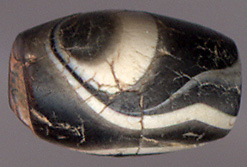
|
SOME THOGHTS ON THE
POWER OF PERFECTION
In this brief exploration, I will take a contrarian
position and sing the praises of the perfect bead. I
consciously undertake this shift to disrupt my own
inclination to elevate a thought-generated insight to
the status of dogma. Indeed, we employ narratives as
tools, but our essence is far more expansive than these
constructs. Therefore, the ultimate course is to engage
with narratives within a meta-narrative framework that
doesn't take narratives as absolute truth.
|
|
|
|
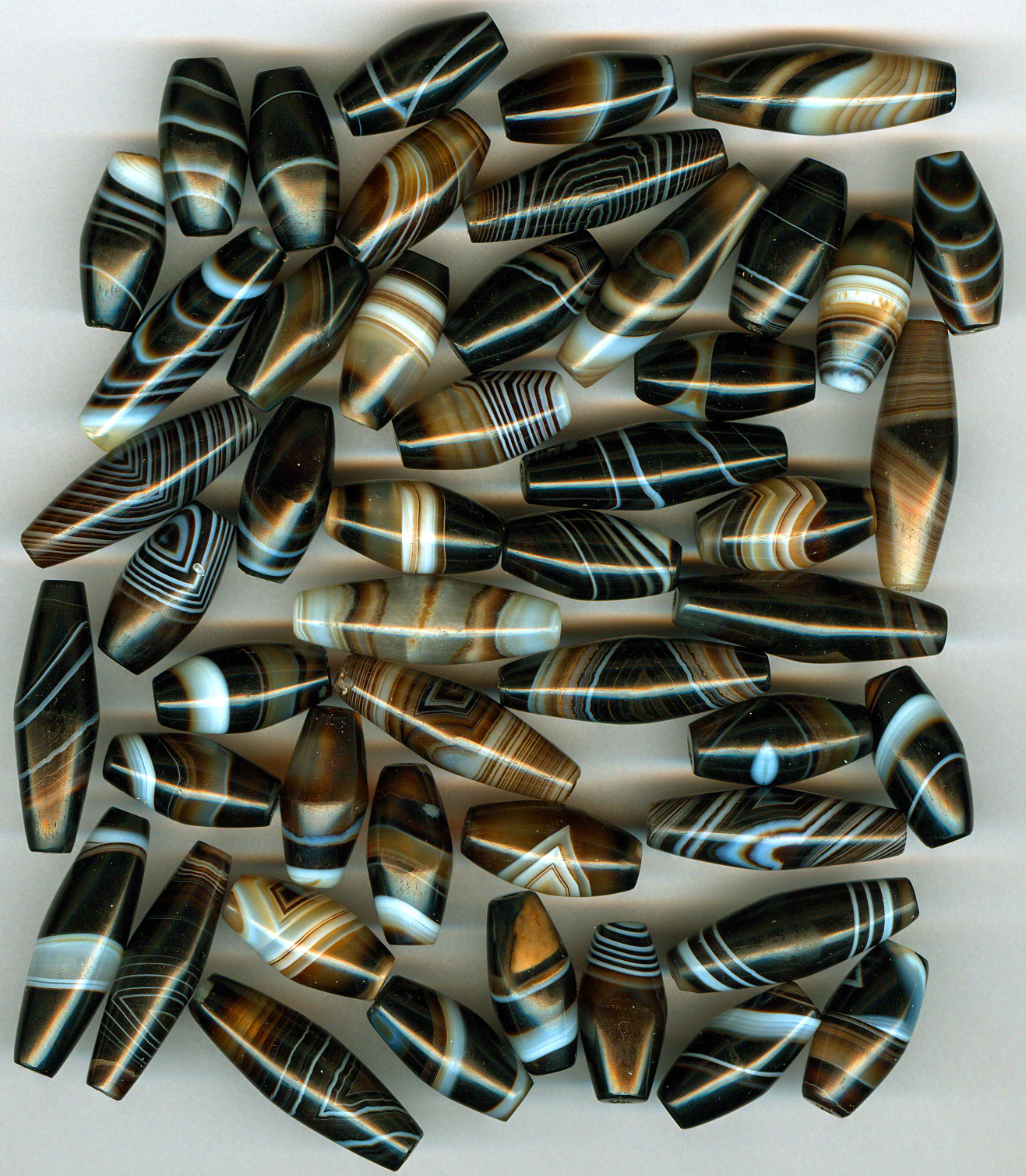
Click on picture for larger image
|
New or not?
Consider the intriguing Burmese
beads showcased above. Observe the graceful curve of light that
dances across their time-worn patina, emanating a soft, soothing
glow that is impeccably uniform across all the beads. Such a
delicate lustre is simply irreplicable in the realm of modern
counterfeits. New beads, freshly polished, tend to radiate a
hard, glaring shine. When counterfeiters strive to mask this
unwelcome gloss, they frequently end up rendering the bead's
surface 'dusty'.
Counterfeit beads usually make their appearance in homogenous
lots, all bearing striking resemblances to one another. In
contrast, these Burmese beads are distinct in their shape,
craftsmanship, and intricate patterns.
Inspecting the beads under a magnifying glass reveals minuscule
marks, vestiges of a time when they were meticulously sanded
with ultra-fine emery paper or a similar medium. These marks are
still discernible, prompting Kevin Ball, a bead connoisseur and
a friend of mine, to speculate that these beads are, in fact,
recent creations. He asserts that had they been interred for
millennia, the natural acids in the soil would have gradually
etched away the beads, causing such delicate marks to vanish
entirely over time.
Armed with Kevin's insightful deduction, I reconnected with the
bead diggers in Myanmar. They assured me that these beads were
unearthed from pH-neutral, sandy soil, a factor they claim
is responsible for the beads' deceptively fresh appearance.
Chemical Environment and
Bead Burial
The chemical constitution of the soil can profoundly impact the
air enveloping the beads during burial. If both the soil and the
air are chemically neutral, it can pose a significant challenge
to distinguish between ancient, buried beads and new ones.
Despite the bead sellers' offer to accept a return, I opted to
retain the beads, given the cumulative evidence at hand.
During my subsequent expedition, I encountered numerous fake
beads, crafted by modern Burmese bead makers. These beads
noticeably lacked the finesse and quality of craftsmanship that
our contentious beads possessed.
As devoted bead collectors, we frequently face uncertainty
regarding the true age of certain beads. We can confidently
discern the antiquity of about 90% of the beads we come across
almost instantaneously. However, the remaining 10% perpetually
plunge us into a realm of doubt and speculation.
Such uncertainty is an inevitable aspect of our passion for
beads. In the case of the beads discussed here, I chose to trust
their antiquity, despite the persistent ambiguity surrounding
their age.
Moreover, counterfeit beads are typically mass-produced and
inundate the insatiable bead market from every possible
direction. This has not been the case with our unique,
intriguing beads. I have yet to stumble upon similar beads
elsewhere. If you, dear reader, have encountered such beads, I
would appreciate your insights.
Price as a Determining Factor
Another critical factor
to consider is the purchase price of the beads. If the cost is
modest, it often signifies a lesser likelihood of deceit. It is
highly unlikely for someone to invest substantial effort into
crafting a convincingly exquisite fake ancient bead, only to
sell it for a meager 3 USD.
Judging solely on artistic merit, producing the beautiful beads
displayed below in the present day would involve considerable
expense. The task of carefully selecting the right piece of
agate from tons of raw material and then coaxing out its unique
artistic or divine patterns would pose a formidable challenge to
any modern bead maker.
Currently, only a handful of craftsmen possess the mastery
needed to 'invoke the divine patterns' from a chosen stone
destined to become a bead. As a general rule, counterfeit beads
are mass-produced in large quantities, often looking identical
and devoid of individualistic traits.
|
|
|
|
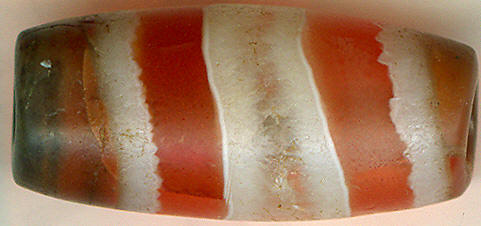
|
|
Ancient Beads & Smartphones
The intersection of ancient beads, smartphones, and the Internet has
significantly transformed the traditional bead trade. Just a few years ago,
there were numerous intermediaries involved between the humble village bead
diggers and the end customers. However, the advent of technology,
particularly smartphones, has revolutionized this system.
In many parts of the world, even a bead digger who lacks access to basic
amenities such as a proper toilet is likely to possess a smartphone. This
has disrupted the traditional bead supply chain, as middlemen are
increasingly being sidestepped. Trade now often occurs directly from the
bead diggers in remote Pakistani villages to customers in bustling Chinese
cities. This newfound connectivity has democratized the trade, enabling
those at the very beginning of the supply chain to reap a greater share of
the rewards.
However, the situation in Afghanistan presents a stark contrast to this
trend. Here, warlords exert absolute control over the bead trade. The
socio-political landscape in Afghanistan, marked by conflict and power
struggles, means that a poor villager simply cannot venture on a solitary
bead hunting expedition. In this setting, the old ways persist, with the
bead trade tightly governed by those in power. This demonstrates how, even
in an increasingly interconnected world, local circumstances and power
structures can significantly shape the way trade and commerce unfold.
|
|
|
|
|
|
|
|
|
|
|
|